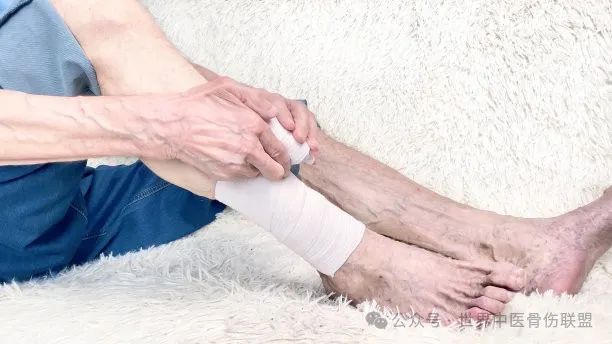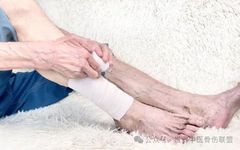In cases of falls, sprains, or blunt injuries, the internal condition of qi and blood stagnation can be reflected in the eyes. The method of eye diagnosis primarily involves observing the presence of red veins in the sclera. If both eyes show red veins (blood vessels), even if there are no external injuries, there is likely internal bruising; if the eyes appear vacant, the prognosis is poor; if the eyeballs feel hot and there is continuous tearing, it indicates a critical condition. For injuries to the thoracic region, there will be corresponding injury points visible in the eyes. Injury points refer to the appearance of purple-red veins on the white part of the eyeball, with blood spots at the ends of the red veins. It is important to note that there must be blood spots at the ends of the blood vessels; otherwise, it is meaningless. The injury points are darker and resemble the size of a needle tip. The appearance of injury points is as follows: if present in the left eye, it indicates injury to the left side of the chest and back; in the right eye, it indicates injury to the right side of the chest and back; at the level of the pupil, it indicates injury to the chest; below the level of the pupil, it indicates injury to the back. If the black circular area is surrounded by a color that is pale like clouds in an irregular halo, it indicates both qi and blood injury; if the injury point is pale like clouds or black with white scattered and not gathered, it indicates injury to the qi level. If the red veins change, showing obvious congestion and curvature, it indicates pain.

Etiology
Injury from falls and blunt trauma is a common traumatic condition, often caused by being struck by foreign objects during work or sudden falls or impacts. After an injury, patients may experience localized pain and swelling, and in severe cases, may be unable to move or speak. Traditional medicine states: “Nine out of ten pains are in the collaterals.” This is due to obstruction of the collaterals after injury, leading to impaired circulation of qi and blood, resulting in local damage. If not treated promptly, the stagnation can lead to adverse effects. General treatment includes external applications and internal medications, primarily focusing on invigorating blood circulation, alleviating pain, and promoting healing. Formulas such as Da Cheng Qi Decoction (大承气汤) and Xiao Cheng Qi Decoction (小承气汤) are commonly used, with a strategy of attacking first and then tonifying or vice versa. This treatment approach often proves difficult for many patients, as the qi and blood are already imbalanced after injury, and taking large doses of aggressive medications can deplete vital energy, leading to symptoms such as dizziness, palpitations, chest tightness, vomiting, etc., worsening the condition.
Symptoms
For patients with isolated abdominal wall injuries, the main symptoms include localized tenderness, possible rebound tenderness, and muscle rigidity. Additionally, a noticeable mass may appear in the abdominal wall with significant tenderness. If there is a concurrent infection, redness, swelling, heat, and pain may also occur. If an abscess forms, a fluctuation sensation may be felt. For injuries within the abdominal cavity, if solid organs such as the liver, spleen, or kidneys are damaged, the main symptoms will be significant bleeding, which can lead to hemorrhagic shock, characterized by cold, clammy skin, rapid pulse, loss of consciousness, or coma. Patients may experience progressive drops in blood pressure and pulse, with increasing heart rate, and in severe cases, may present with oliguria, anuria, or even hematuria. For hollow organ injuries, gastrointestinal bleeding may occur, presenting as hematemesis or melena, along with symptoms similar to hemorrhagic shock. Perforation typically presents with obvious peritonitis, with significant abdominal pain, accompanied by nausea and vomiting, tenderness, rebound tenderness, rapidly spreading throughout the abdomen, decreased or absent bowel sounds, and a reduced liver dullness area, which can be clarified through further examinations.
Examination
For injuries to the thoracic region, injury points will appear in the eyes. Injury points refer to the appearance of purple-red veins on the white part of the eyeball, with blood spots at the ends of the red veins. It is important to note that there must be blood spots at the ends of the blood vessels; otherwise, it is meaningless. The injury points are darker and resemble the size of a needle tip. The appearance of injury points is as follows: if present in the left eye, it indicates injury to the left side of the chest and back; in the right eye, it indicates injury to the right side of the chest and back; at the level of the pupil, it indicates injury to the chest; below the level of the pupil, it indicates injury to the back. If the black circular area is surrounded by a color that is pale like clouds in an irregular halo, it indicates both qi and blood injury; if the injury point is pale like clouds or black with white scattered and not gathered, it indicates injury to the qi level. If the red veins change, showing obvious congestion and curvature, it indicates pain.
Differentiation
The method of eye diagnosis primarily involves observing the presence of red veins in the sclera. If both eyes show red veins (blood vessels), even if there are no external injuries, there is likely internal bruising; if the eyes appear vacant, the prognosis is poor; if the eyeballs feel hot and there is continuous tearing, it indicates a critical condition.
Complications
1. Increased Pain
After injury from falls and blunt trauma, local tissues are damaged, and nerves are stimulated, resulting in severe pain. Increased pain may prevent the patient from normal activities or bearing weight, further affecting the recovery of the injured area.
2. Worsening Swelling
Worsening swelling is usually due to ruptured subcutaneous capillaries, blood extravasation, and accumulation of tissue fluid caused by the injury. Swelling may compress surrounding structures, causing further discomfort or even infection. In severe cases, it can lead to limited mobility.
3. Functional Impairment
Long-term functional impairment may result from untreated soft tissue injuries, leading to joint stiffness, muscle atrophy, and other issues. This can limit the patient’s ability to perform daily activities, reduce quality of life, and potentially lead to long-term disability.
4. Continuous Bleeding
Continuous bleeding is due to microvascular rupture caused by blunt trauma, and conditions such as thrombocytopenia may also lead to difficulties in hemostasis. Significant blood loss can result in anemia, coagulopathy, and other complications, and in severe cases, may threaten life.
Treatment
1. Cold Compress If the patient experiences swelling, pain, or other symptoms, a cold compress using ice wrapped in a towel should be applied to the affected area. Cold compresses can constrict capillaries, thereby alleviating pain and reducing swelling.2. Heat Compress Once the above discomfort symptoms are alleviated, a heat pack or warm compress may be applied to the injured area under the guidance of a physician. Increasing skin temperature can promote blood circulation, thereby reducing swelling and bruising.3. Blood-Invigorating and Stasis-Resolving Chinese Herbs Blood-invigorating and stasis-resolving herbs include Hong Hua (Safflower), Tao Ren (Peach Kernel), and Dang Gui (Angelica Sinensis). Patients may follow medical advice to select appropriate herbs for decoction. These herbs have certain effects on promoting qi and blood circulation, helping to alleviate symptoms caused by internal injuries from falls.4. Non-Steroidal Anti-Inflammatory Drugs Commonly used non-steroidal anti-inflammatory drugs include ibuprofen sustained-release capsules and diclofenac sodium sustained-release tablets. Patients should strictly follow the dosage instructions. These medications can inhibit prostaglandin synthesis, providing analgesic and anti-inflammatory effects, effective for mild to moderate pain associated with blunt trauma.5. Muscle Relaxants Muscle relaxants include etizolam and compound chlorzoxazone tablets, and patients should follow physician guidance for proper use. These medications can reduce muscle tension and alleviate muscle soreness caused by soft tissue injuries from falls.
Prevention
1. Warm-up exercises: Walking, stepping, jumping, stretching, etc., to mobilize all joints of the body.
2. Wrist, knee, and ankle guards are necessary.
3. Follow the principle of a 10% increase; do not increase frequency, intensity, or duration by more than 10% within a week, progressing gradually.
4. Maintain a balance of aerobic and anaerobic exercises. Participate in strength and flexibility training to prevent injuries.
5. Learn various self-protection methods for falling, such as rolling appropriately upon landing to cushion the impact.
6. Master scientific knowledge of exertion to prevent improper force application.
Professor Song Yongzhong

Professor Song Yongzhong, President of the World Traditional Chinese Medicine Orthopedics Alliance, CCTV-1 Health Consultant, Health Guest of Daily Health Hall, Director of Beijing Beiyuan Traditional Chinese Medicine Clinic, Deputy Secretary-General of the Youth Enterprise Committee of the Central Committee, Mentor of Traditional Chinese Medicine, from a family of traditional Chinese medicine, an expert in orthopedics, and a renowned physician in Beijing. Upholding medical principles, forming a unique lineage; with Song-style traditional Chinese medicine for bone setting and Song-style qi and blood regulation, becoming the core of traditional Chinese bone setting inheritance (treating hundreds of thousands of patients, training over ten thousand bone-setting students, and accepting over 300 apprentices)


